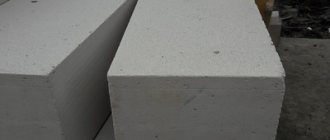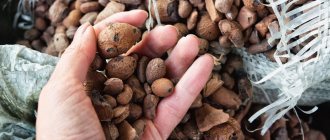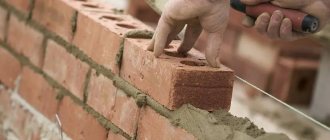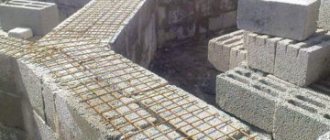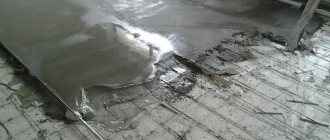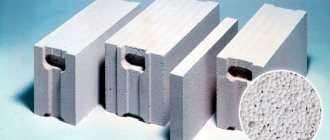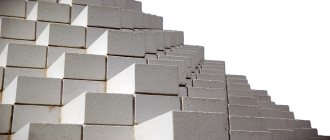Wood concrete is a building material used for the construction of walls.
It can be classified as lightweight concrete, since it consists of 80% organic filler. The material can be used in low-rise buildings. When planning construction, it is important to calculate the mass of wood concrete blocks and the load on the foundation.
This can be done using special formulas, based on the size of the product.
What is the material
Arbolite has been used in construction for quite some time.
The requirements for the material are established in GOST 19222*84. For the production of wood concrete, a binder (cement) component, organic fillers and additives are used to adjust the characteristics. The material is used for the construction of structures for various purposes.
Arbolite (wood block)
The composition of the mixture (content of cement, water and chemical additives) for the manufacture of the material may vary depending on the type and fraction of organic matter.
In accordance with the current standard, manufacturers produce two types of wood concrete.
Table. Types of material.
| Material | Density, kg/m3 | Compressive strength, grade |
| Thermal insulation | 400…500 | M5, M10, M15 |
| Structural | 500…850 | M25, M35, M50 |
The scope of application of structural wood concrete is the construction of low walls (2, 3 floors) and partitions, installation of lintels over openings and armored belts. Thermal insulation material is needed for thermal insulation of walls and ceilings, as well as noise protection. The construction of load-bearing structures from products made of wood concrete having a density below 500 kg/m3 is prohibited.
Laying arbolite blocks
Type of wood concrete and characteristics
The relative humidity inside arbolite buildings should not exceed 60%. The presence of an aggressive gas environment is also not allowed.
Wood concrete is used to produce blocks, which are most in demand among consumers, and panels (they are mainly used for insulating floors).
Wood concrete wall panels
What characteristics do wood concrete blocks have?
The thermal conductivity coefficient of the material, depending on the organic filler, can be:
- 0.08...0.17 W/(m×°C) - for products containing wood;
- 0.07...0.12 W/(m×°C) - for products with other types of filler.
This thermal insulation ability of the material allows a wall just 30 cm thick to resist the penetration of cold just as effectively as a meter-long brick one.
When shipped to the consumer, wood concrete should not have a moisture content exceeding 25%.
The frost resistance of the material can be F 25 or F 50. In terms of resistance to biological damage, it belongs to group V. Wood concrete can withstand fire for up to 90 minutes.
Comparison of wood concrete with other materials
Arbolite blocks can be reinforced. In this case, welded mesh or rod steel with a coating that protects against corrosion is used. The thickness of the concrete layer to the reinforcement should not be less than 1.5 cm. Embedded parts can also be installed in the wood concrete.
How to reinforce arbolite blocks
How many pieces of wood concrete are in a cube? Standard block 500x300x200
Arbolite blocks of the standard class are preferable for the construction of industrial and residential buildings in central Russia, although a wall with optimal thickness will be able to overcome any frost. A standard wood concrete block maintains temperature without a greenhouse effect, since the material is well ventilated thanks to a structure with a significant number of pores.
Standard arbolite blocks can be laid on the rib surface: 20-25 cm will be enough to recreate the thickness of the walls of any enterprise with a high level of humidity, while the financial benefit will be obvious.
CHARACTERISTICS
| Density | Brand strength | Thermal conductivity | Frost resistance | Moisture absorption | Weight | PC. cubed | PC. on a pallet | |
| Standard block 500 x 300 x 200 mm | Density 550-650 kg/m3(D600) | Grade strength M25 (B1.5) | Thermal conductivity 0.12 W/(mS) | Frost resistance F50 | Moisture absorption 60% | Weight 19 kg | PC. cubed 33.3 | PC. on pallet 48 |
Laying a standard wood concrete block
The blocks are laid in the traditional way, as it will be sufficient to provide thermal insulation in various climatic conditions.
The laying composition can be varied: traditional cement, perlite-based, concrete adhesive. The thickness of each layer of the mixture is about 2-5 mm, which ensures high stability, allows you to save money and form a neat seam, as well as prevent the appearance of “cold” bridges Price: 5000 rub.
Advantages and disadvantages of arbolite blocks
It should be noted that in the last century, wood concrete was used not only for the manufacture of wall blocks, but was also produced in the form of sheets, which were used for insulation and soundproofing of floors.
Today, wood concrete is practically not used in this capacity, because its main advantages are revealed during the construction of low-rise buildings. Let us list them in more detail.
— Low thermal conductivity
Wood concrete wall blocks belong to the category of effective heat-insulating materials. This is evidenced by the following fact: a wall made of wood concrete with a thickness of only 30 cm retains heat just as well as brickwork a meter thick.
Therefore, reviews from owners of houses made of wood concrete blocks primarily note significant fuel savings even in the coldest winters.
— Durability
The strength of wood concrete blocks directly depends on their density. For structural and thermal insulating wood concrete with a density of 600-650 kg/m3, it ranges from 20 to 35 kg/cm2. According to this indicator, wood concrete is practically no different from its main competitors - foam and aerated concrete.
An important advantage is the plasticity of this material. This fact is explained by the fact that the composition of arbolite blocks includes wood chips that reinforce this material. Therefore, under load, wood concrete does not crack, but only slightly deforms without loss of integrity.
By building a house from wood concrete, you will not have to spend extra money and time on pouring a reinforced concrete belt, which is necessary for fragile walls made of gas and foam concrete blocks.
— Frost resistance
Wood concrete's frost resistance (the number of freezing-thawing cycles in a water-saturated state) ranges from 25 to 50. In practice, this means that a house made of this material will last at least 50 years (confirmed by studies of existing buildings). Foam blocks have a resistance to freezing and thawing that does not exceed 35 cycles.
Speaking about the advantages of wood concrete, we should also talk about its low carbonization shrinkage. This term refers to the process of loss of strength of cement stone due to reaction with atmospheric carbon dioxide, which results in soft chalk.
— Good sound insulation
For arbolite blocks in the acoustic range from 125 to 2000 Hz, the sound absorption coefficient ranges from 0.17 to 0.6. For brick, this indicator is almost four times worse. For wood it ranges from 0.06 to 0.1, which is also significantly less than for wood concrete.
- A light weight
1 m3 of blocks made of structural and thermal insulating wood concrete weighs almost 3 times less than brick and almost 1.5 times less than expanded clay concrete. This allows you to significantly reduce the cost of constructing foundations for arbolite walls.
— Environmental friendliness and durability
Wood concrete is one of the most environmentally friendly building materials, since it contains only natural ingredients - cement stone, wood chips, water, calcium chloride (used in the food industry) or ordinary milk of lime.
This material behaves excellently in walls because it does not rot, is not susceptible to mold, and does not burn. In addition, wood concrete breathes well and regulates air humidity in the room, absorbing excess moisture and releasing it when there is a lack.
— Non-flammability
Arbolite belongs to the group of low-combustibility materials (flammability group G1). In addition, wood concrete is a low-flammable material (flammability group B1) and a low-smoke material (D1).
— Ease of processing
Wood concrete is easily processed with any mechanical tool. It can be sawed and drilled and holds nails and screws well. The rough surface of the blocks is an ideal basis for applying plaster solutions without the use of reinforcing mesh.
The disadvantages of wood concrete blocks include the low accuracy of geometric dimensions. Therefore, walls made of this material require leveling with plaster solutions or sheet finishing materials (plasterboard, magnesite, lining, siding).
Since the wood concrete manufacturing technology is based on the use of wood chips, a fairly expensive material, the cost of wood concrete blocks exceeds the price of aerated concrete by an average of 15-20%.
Construction of houses from wood concrete is a worthy investment in a healthy future
What is built from wood concrete? As mentioned earlier, in our country wood concrete began to be used in the form of wall panels, from which apartment buildings were mainly built. Nowadays, suburban housing is becoming popular, so wood concrete has become very popular in private low-rise construction, and also copes “excellently” with the task of building baths , despite the average moisture resistance, since it has low hygroscopicity and dries quickly after water procedures. In addition, when heated and at high temperatures in the bathhouse, the block gives off its woody smell, which creates a special aromatic atmosphere. A bathhouse made of wood concrete is not subject to rotting, unlike a wooden bathhouse, since the wood chips inside the block are insulated and pre-treated with a mineralizer and, accordingly, are more resistant to fire.
Wood concrete belongs to the group of low-flammable and fire-resistant materials.
Arbolite blocks are also successfully used for the construction of poultry and livestock buildings.
The article was prepared based on materials from the plant producing arbolite blocks "Novintech" in Nizhny Tagil arbolit66.ru.
Negative properties of wood concrete
Despite the abundance of useful qualities and properties, wood concrete also has negative qualities that you need to know about in order to be able to take them into account. Thus, the following facts may raise questions and doubts when choosing a building material:
The presence of a large number of low-quality products on the market. The quality and objective characteristics of material produced in artisanal conditions can neither be guaranteed nor even accurately assessed, since outside of factory production it is very difficult to meet all regulatory requirements for the technological process, while in the regions it is not always easy to find factory products for sale, since its volumes are not very large.
Instability of the geometric dimensions of the blocks. Inaccurate correspondence of the dimensions and orientation of the surfaces of wood concrete blocks often causes problems during masonry, forcing an increase in the thickness of the seams, and this leads to excessive consumption of material, a decrease in the speed of work, and also worsens the overall properties of the finished structure. The reason often lies in the use of manual labor in production. It is still possible to counter this drawback: it is recommended to use warm perlite mortars when laying, at the same time manufacturers are working to improve the accuracy of the geometry of the blocks by milling their surfaces.
Moisture permeability of unprotected surfaces. There is an unconfirmed assumption that masonry made of arbolite blocks, not covered with any protection, can be permeable even to strong winds
But you can easily protect the structure from external influences by finishing the exterior surface.
Price of blocks. Since the production process of wood concrete blocks usually combines a not very high production volume and a low degree of automation of the process, the cost of the finished product can be one and a half times higher than that for foam concrete and aerated concrete blocks.
Limited choice of finishes. In fact, when working with structures made of wood concrete blocks, it is important to follow only one rule: combine exclusively “breathable” finishing options with wood concrete masonry.
What problems may arise during construction?
- Strong, durable structures can be erected using only high-quality material produced according to GOST standards, in compliance with all production instructions. Unfortunately, the market is overflowing with low-quality goods, among which it is quite difficult to choose the right one.
- Shortage of highly qualified specialists. An illiterate approach to construction and ignorance of the characteristics of the material negates all its positive characteristics. Using such blocks in construction, a mason must observe many nuances that determine the quality of his work. For example: wetting the surface before applying the solution, a perfectly thin and even seam. Finding such a master is difficult. The demand for high-quality professionals is great, and sometimes it is necessary to delay construction deadlines just to wait for the right person or team.
- It is impossible to erect a building from wood concrete slabs in conditions of high humidity without constructing a basement floor or a pile foundation.
When starting construction in a lowland or on marshy soils, wood concrete houses must be raised above the soil level.
Comparison of the characteristics of wood concrete blocks with other building materials
In order to understand whether wood concrete blocks are suitable for construction, it is worth making a comparative analysis of the properties of the most popular building materials.
Comparison of the properties of wood concrete, timber, cellular concrete and brick:
| Material property | Brick | Cellular concrete | Wooden beam | Arbolit |
| The degree of difficulty in attaching the home structure to the wall | Special fasteners | Expensive special fasteners designed to work with fragile materials | Attaches perfectly with screws, nails, or regular dowels | Excellent fastening with screws, nails, regular dowels |
| Construction and commissioning period | A lengthy and expensive process, as insulation and finishing are required | Fast construction of walls. A lot of time is spent on external insulation of the facade. This is a time consuming and expensive process. | Due to shrinkage of the material a year after construction, finishing work will be required | Fast construction of walls, extra. no insulation required, finishing can be done immediately |
| Foundation cost | Expensive, massive | Expensive massive monolithic strip foundation | Economical, lightweight | Lightweight, economical |
| Microclimate at home | It will be necessary to organize forced ventilation of the room | weak-breathing | Removes high humidity and breathes | Removes high humidity and breathes |
| Flexural strength | Fragile, does not bend | Lacks plasticity, brittle, gives massive cracks when the foundation vibrates, does not tolerate transportation well | Works well for bending | Works well in bending, does not crack when the foundation vibrates, tolerates transportation well |
| Biostability | Biostable | Biostable | Rotting | 5 biostability group |
| Fire resistance | The material is not flammable | The material is not flammable | Highly flammable | Doesn't support fire |
| Thermal conductivity, Watt/(m×°C) | 0,560-0,850 | 0,140-0,320 | 0,150 | 0,07-0,17 |
| Density, kg/m³ | 1150-1950 | 200-1200 | 450-600 | 400-850 |
The vapor permeability of wood concrete blocks is only slightly less than that of wood. Thanks to this property, in houses made of wood concrete, the level of humidity is always optimal. The strength of arbolite blocks does not depend on the degree of absorption and evaporation of moisture, therefore, when it is transferred, the walls are not destroyed.
Comparison of wood concrete with other building materials
Helpful advice! When choosing products, pay attention to the sides of the products. If one of their ends is smooth, and all the others differ significantly from it, it is better to refuse to purchase the proposed batch, since this sign indicates that the wood concrete production technology was violated, and the cement simply flowed down
The quality of wood concrete is significantly influenced by the degree of sawdust drying. If only dry wood chips were used, then the internal moisture content of the blocks will never become critical, so the wall built from them will not be afraid of frost. When wet sawdust was used, it is possible that after a few winters the wood concrete will begin to lose strength. Indeed, at negative temperatures, water will freeze, increasing in volume, which, in turn, leads to the destruction of the binder component.
Other practical properties of this material are worth highlighting:
- tensile loads are not scary;
- resistance to mold and rot;
- not afraid of fire.
Arbolite blocks can have a variety of shapes, so during construction you can do without adjusting and cutting conventional elements
Thanks to the latter property, the fire hazard level of arbolite houses is closer to that of stone and brick buildings than of wooden structures. However, if a large-scale fire occurs inside the building, or it is in the zone of a large fire, the walls will lose a significant part of their strength. Reinforced concrete, stone and brick are less prone to such consequences, which cannot be said about other types of lightweight concrete.
Why do you need to know?
When designing, one of the important stages is the calculation of the entire structure and individual elements. When calculating the foundation, you need to know the load from the walls and roof.
This parameter of wood concrete affects the following factors:
- Floors in the house. If it is necessary to lay reinforced concrete slabs, it is necessary to choose a heavy material for the walls. Low-density wood concrete can withstand wooden floors.
- When choosing a foundation, you should pay attention to the weight of the walls and roof. These factors directly affect the depth of the structure. When designing a house with lightweight wall material, you can choose a shallow pile or strip foundation. In other cases, a serious foundation will be required, which will cost about 1/3 of the entire estimate.
- When laying wood concrete, you should pay attention not only to size. Even large products will be arranged with ease if their mass is relatively small. Thus, blocks with a small value simplify the work and also reduce construction time. With this material, you can install the walls of a small house in 5-7 days.
- Delivery of material to the site. A truck can bring a large number of blocks with low weight.
Advantages of building material
In Russia, the characteristics of wood concrete blocks are specified in GOST 19222-84 “Arbolite and products made from it”. This document provides for the production of two types of blocks - thermal insulation (density up to 500 kg/m3) and structural (density 500-850 kg/m3). For production, they use chips of coniferous and deciduous wood, flax, and straw. The general properties of arbolite blocks, more often called simply arbolite, are as follows:
- low thermal conductivity - 0.07-0.18 W/m;
- grade for compressive strength - for heat-insulating wood concrete B 0-B 1.0, for structural concrete B 1.5-B 3.5;
- frost resistance - 25-50 cycles;
- flammability group G1 - low flammability, does not support combustion;
- plasticity - due to the high chip content, the block does not break when bent and is capable of restoring its original shape;
- vapor permeability;
- light weight - 3 times lighter than a brick of the same volume;
- environmental friendliness - does not emit harmful substances;
- resistant to rot and mold;
- low cost - up to 90% of the mass of the block is wood chips.
The technology for producing wood concrete is quite simple, so self-produced blocks are often used for the construction of individual residential buildings.
To make blocks, wood chips up to 40 mm long, 5-10 mm wide and up to 3-5 mm thick are treated with additives to improve adhesion (liquid glass, calcium chloride or nitrate, aluminum sulfate), dried for a month or two, stirring regularly. Dry shavings are mixed with cement of a grade not lower than M 400, then filled with water and mixed thoroughly. To obtain chips of the required size, a special device is required; to obtain a high-quality mixture, a concrete mixer is used; for molding, a vibrating table and split molds are used.
The finished mixture is poured into the mold. By loading the mold, you can achieve a more correct and uniform geometry of the products. After 3 days, the block is removed and sent for ripening in a dry, heated room. The blocks are easy to cut, saw and drill, and hold nails well.
Attention! It is allowed to build houses from wood concrete up to 7 m high; as a rule, this is a 2-story or one-story house with an attic.
To ensure the normal resistance to heat transfer of enclosing structures, a wall with a thickness of 380 mm is sufficient, but in fact, masonry with a thickness of 300 mm is more often performed, with the external and internal surfaces of the wall protected with warm plaster on porous fillers.
The blocks are produced in several standard sizes, the most commonly used size is 500x250x300, the masonry is carried out with bandaging of the seams of each row. In addition to solid ones, they produce hollow products, products with a front finishing layer, and profile blocks for lintels.
Arbolit: what is it?
Wood concrete (wood concrete) is an arbolite, the name of which comes from the French word for “tree” (arbre). The material is made from three components - from wood chips (spruce, larch, pine), cement and chemical additives. The fourth essential component is water.
Wood chips
90% of the composition is wood waste. The strength of this building material largely depends on the type of raw materials used for the production of wood concrete blocks. Wood chips must be well dried and have a certain size. If we talk about the maximum, then these characteristics are as follows: thickness 5 mm, width 10 mm, length 40 mm. However, the best indicators are considered to be 3-5 mm, 5-10 mm, up to 25 mm, respectively.
Coniferous trees are used more often, deciduous trees less often. Flax fire, straw, cotton stalks, shavings or sawdust are raw materials that are undesirable for the manufacture of wood concrete. The ideal is wood chips without the addition of leaves, bark or other similar impurities. The presence of the first 2 ingredients is acceptable (5% leaves, up to 10% bark), but it is still not welcomed by builders.
Manufacturers engaged in the production of wood concrete blocks on-the-job (in sawmills, other woodworking companies) do not always strictly monitor the composition of the product. Some of them add what is available to wood concrete blocks, so the quality of such building materials is often much lower than required.
Cement
For any construction work, it is recommended to choose fairly high-quality cement grades: at least M400. The reason for this is the loss of some of its properties already during storage. Therefore, even the products coming from the factory to some extent do not correspond to their strength characteristics.
The requirements for the components of wood concrete, which is a lightweight type of concrete, are stricter. In order for the building material to meet all requirements, it is made from M500 cement. Such products guarantee sufficient strength.
Mineral supplements
In the production of wood concrete it is allowed to use liquid glass, lime, aluminum sulfate (alumina sulfate, aluminum sulfate), silicate block, calcium chloride. Mineralization is necessary to protect the material from biological threats, from exposure to moisture, and to increase the adhesion of such dissimilar components.
Mineral additives are added to the water in advance. First, the liquid is mixed evenly with the wood chips for 20 seconds. Then cement is added to the semi-finished product, which is mixed with wood chips longer - for 3 minutes.
Big difference: sawdust concrete and wood concrete
Some call wood concrete sawdust concrete, but these are completely different materials. The main component of wood concrete is wood chips, and the second component is sawdust, which does not have reinforcing properties.
For this reason, products made from small waste quickly become deformed and destroyed. Another disadvantage of sawdust concrete is the addition of a larger (than necessary) proportion of sand. This violation of technology is the secret of unscrupulous manufacturers. The logical result of this “crime against humanity” is the crumbling walls of the house.
Arbolite blocks, price per piece of the most popular types
Modern industry produces two types of wood concrete - structural and thermal insulation. The second type of material is not used in the construction of external and internal walls, since it is characterized by a relatively low density and relatively low weight. It is successfully used for insulating buildings, residential buildings made of brick, expanded clay concrete, and other building elements.
To create load-bearing walls, structural type blocks are required. Their strength and density indicators are higher than those of similar products made from heat-insulating wood concrete.
Comparative characteristics of thermal insulation and structural wood concrete:
| Wood concrete type | Application in construction | Compressive strength class | Strength, kg/cub.m | Density, kg/cub.m |
| Thermal insulation | Wall insulation | B 0.35-1.5 | M5, M10, M15 | 400-500 |
| Structural | Construction of load-bearing walls | B1.5-B3.5 | M25, M35, M50 | 500-700 |
The most popular types of these products include wood concrete blocks of the following types:
Large blocks of wood concrete are used for masonry walls that are subject to heavy loads
small arbolite blocks. They are mainly used for laying insulating rows and for erecting non-load-bearing light walls. Block size - 190x190x300 mm. Brands – D500, D600. As for the price of wood concrete blocks of this type, it fluctuates around 60 rubles/piece.
Arbolite blocks: price depending on the scope of application
The cost of the product in question is also affected by what it is used for, as well as the configuration of the individual product.
Helpful advice! Buy wood concrete blocks that have no white coating on their surface. This is evidence of the addition of glue, which is not allowed according to technology.
Scheme of wood concrete blocks intended for insulation of wall structures
Let's consider data on brands of wood concrete products with an indicator of 600-650 kg/m³. The indicators presented in the table are indicative, since they may differ in different regions of the country.
Cost of different types of blocks and their characteristics:
| Type | Price per 1 cubic meter, rub. | Number of pieces in 1 cube | Approximate weight pcs/kg | Dimensions, mm |
| U-shaped block with a recess for armored belts or window lintels | 4900 (148.48 per 1 piece) | 33 | 12 | 500×200×300 |
| Septal | 5100 | 53,3 | 11,5 | 150×250×500 |
| 5000 | 40 | 15 | 200×250×500 | |
| Wall | 4300 | 26,6 | 22,5 | 300×250×500 |
| 4200 | 20 | 30 | 400×250×500 |
Calculation of the mass of 1 block and 1 m3
In order to calculate the mass of 1 block, you need to know the number of pieces per cubic meter and its weight.
Let's consider the most popular standard product size 500x300x250 mm. It can be used for the construction of walls with a thickness of 300, 250 and 500 mm. To calculate, you must perform the following steps :
- All sides of the product should be multiplied. For convenience, it is recommended to calculate all values in meters. It turns out 0.3x0.25x0.5 = 0.0375 m3.
- Then 1 cubic meter is divided by the resulting value: 1: 0.0375 = 27 pcs.
- 1 cubic meter of blocks of this size weighs 607 kg. Therefore, in order to find out the value of 1 product, it is necessary to divide the total mass by the quantity per cube. 607:27=22.5 kg.
In this simple way, you can calculate the mass of one product, knowing its dimensions.
Technical characteristics and comparison with other building blocks
Arbolite guarantees disadvantages and advantages that are quite clear - the only unexpected point may be the low quality of the material itself. If the blocks are made according to technology, from correctly selected components and in compliance with proportions, then all properties are quite predictable.
Main technical characteristics of wood concrete:
- Density - in the range of 300-850 kg/m3 (depending on the type, because wood concrete can be structural and thermal insulating): the higher the value, the higher the load-bearing capacity and the lower the thermal insulation value.
- Strength depends on density: for wood concrete with a density of 400-500 kg/m3 it is B0.35, for 700-850 kg/m3 it is B3.5. This is quite enough for the construction of load-bearing structures of a 2-3-story building.
- Thermal conductivity also directly depends on density, increases proportionally: for blocks with a density of 400 kg/m3 the indicator is 0.06 W/m K, at 850 kg/m3 the thermal conductivity coefficient is within 0.17.
- Water absorption - for thermal insulation blocks the parameter is 85%, for structural blocks 75%. Wood concrete absorbs and releases moisture during drying, but it is not recommended to use it where constantly high humidity is noted (or each wall made of wood concrete will have to be carefully plastered and covered with insulators).
- Fire resistance - the material is considered low-flammability with index G1 (capable of withstanding an open flame for one and a half hours without changing the geometry).
- Frost resistance – F50, which is equal to the number of freezing/thawing cycles.
- Resistance to tension - when the foundation moves, it shows susceptibility to the appearance of deformations and cracks by 0.4-0.5%.
- High level of sound absorption.
- Good vapor permeability indicators - wood concrete can be used for the construction of saunas and baths.
If you compare wood concrete blocks with other building materials, then all the advantages and disadvantages become more obvious. Some parameters are shown in the table:
Comparison of wood concrete with some materials:
Brick is more dense in structure, and therefore more durable in compression. But wood concrete retains heat better: a wall 50 centimeters thick is equal to the thickness of a brick wall of about 120 centimeters. At the same time, the dimensions of the wood concrete are larger, so the laying is faster and easier.
Wood - materials are similar in thermal conductivity and density, but natural wood is much more expensive, more difficult to transport and install, and requires more careful maintenance. In addition, wood rots and burns.
Foam concrete - foam block is also light in weight and density, but due to its porous structure it involves additional costs for reinforcing the masonry, making the construction process longer and more complex. Thermal insulation of wood concrete is 75% higher.
Additionally, you can view the parameters here:
How many cubes of wood concrete are needed for a house? We calculate arbolite blocks for the house and cube walls
After we have bought a ready-made standard one or ordered an individual project for a future house from an architect, we will need to perform an additional calculation to determine the required number of wood concrete sides.
This will help us determine the cost of the material and the scope of work for the overall construction. From the project we know exactly how many cubes of blocks we will need, and how many blocks in one cube still need to be counted. Arbolite is an excellent alternative to standard concrete and brick. The material has increased thermal insulation, strength and durability. It is chosen to facilitate the construction process, since the construction of a house requires much less volume when compared with other building materials. Before you buy blocks, you need to calculate the required quantity. There are many calculators on the Internet, but in order to perform the calculation correctly, you need to understand how it works.
If the design was carried out by a professional, then you should already know what materials will be used in construction.
The two sizes most commonly used are:
- 500x300x200 mm - for load-bearing walls.
- 500x150x120 mm - for partitions.
Sometimes you can find projects with blocks 400x200x200 mm. Without complete project documentation, you will not be able to find out how much wood concrete is needed for a house. It is also recommended to find out in advance how much square footage the doorways and windows take up. If this stage has already been completed, you can begin calculations.
Approximate calculation of how much wood concrete is needed for a house
To perform the calculation, you need to know the length of all load-bearing walls of the future building. We also need to know the thickness of the walls, this indicator is the same almost everywhere - load-bearing walls have a thickness of 300 mm, and interior partitions - 150 mm. The next parameter that is needed in the calculations is the height of each floor. In order for the calculations to be accurate, it is necessary to know the general square footage of windows and doorways.
The number of blocks is calculated according to the following scheme:
- It is necessary to calculate the perimeter of the house; to do this, the length of all the walls must be added up - this will be the total length.
- To get the total height, add the height of each floor.
- Next, we multiply the total height of the building by the total length of the load-bearing walls.
- From the resulting amount, subtract the area of window and door openings.
- The result obtained should be multiplied by the number of blocks required for laying 1 m2 of wall.
- Done, now you know how many blocks your house will need.
For example, you can take a standard 6x6 m house:
- total length of walls - 36 m;
- total height of walls - 9 m;
- total area of windows and doors - 11 m2;
- we use blocks 500x300x200 mm - to build 1 m2 of wall you will need 10 pieces. such blocks.
Now the calculation:
Nblocks per house=(36*9 –11)*10=3130 pcs.
In this example, we neglect the masonry seam so that we have a supply of building material in the region of 5–7% for additional blocks and scrap. And of course, we simplified the numbers for the sake of the example.
As you can see, having a plan for the future construction, you can independently calculate how much wood concrete you will need for your house. This way you can save money and check the contractors. If you are planning to hire workers, then it would be useful to double-check how much work they will include in your estimate.
How many blocks are in one cube?
For further calculations, you also need to know how many blocks are in one cube. First, let's look at the standard material for load-bearing walls with a size of 500x300x200 mm - 33.3 pieces in one cube.
Above, we carried out the calculation and found out that for a standard 6x6 construction, 3130 pieces are needed, now let’s convert this figure into volume:
Vpage material=3130/33=95 m3.
Separately, you need to find out the volume for bulkheads for which wood concrete is used 500x150x200 mm, in one cube of which there are 66.6 pieces. Also in construction, wood concrete with a size of 400x200x200 is used - in this case there will be 62 pieces in 1 m3.
We have given examples so that you understand how the calculation of wood concrete blocks per house is carried out. To make this step easier, you can use a special construction calculator - you will only need to indicate the basic data that we have listed. But calculators usually show only the basic dimensions, and your construction may use blocks of a different size.
Technology for the production of wood concrete blocks
Arbolite belongs to lightweight concrete, the technology is almost standard, with the exception of some nuances: the need for pressing and the use of a forced concrete mixer when mixing, not an ordinary gravity one. It mixes the wood chips better with the other ingredients.
Compound
The composition of wood concrete includes four components:
- high-quality cement (M 400 or M 500);
- wood chips;
- water;
- chemical additives.
Wood concrete composition
The cement must be dry and fresh. Chips are of a certain size. The less misgrading there is, the stronger the block will be. Chemical additives are calcium nitrate and chloride (food additive E509), liquid glass, aluminum sulfate and some other substances
Please note that they are first diluted in water and only then added to the wood chips and mixed. Any drinking water is allowed, but not industrial water, without contamination
After the wood chips are evenly wet, cement is added. Any other sequence is not allowed.
Types and sizes of blocks
Depending on the density, wood concrete blocks are divided into thermal insulation (up to 500 kg/m3) and structural (from 500 kg/m3 to 850 kg/m3). To build one-story houses, you can use the lightest structural ones with a density of 500 kg/m3. For mansions of 1.5 and 2 floors, the minimum density is 600 kg/m3 and above.
The sizes of arbolite blocks can be different. The most common is 500*200 mm and different thicknesses - from 100 mm to 400-500 mm. But different factories and workshops produce blocks of different sizes. The molds for them can be welded from ordinary sheet iron, so this is not a problem. The photo shows an example of the assortment of one of the workshops.
Dimensions and weight of wood concrete blocks
As you can see, blocks of 600*200 mm and 600*250 mm are also available and thicknesses range from 100 to 500 mm. You can choose suitable ones for load-bearing walls and interior partitions. You can also make a suitable shape for making wood concrete blocks yourself. That is if you decide to make them yourself.
Proportions
Like any building material, wood concrete is divided into strength classes. For the construction of load-bearing walls of houses, the required strength class is B 2.5.
The number and proportions of wood concrete components depending on the brand
The amount of necessary materials per cubic meter of wood concrete mortar is in the table (photo above).
Pressing technologies
All these components are mixed and blocks are formed from them. There are several technologies:
- simply by pressing: manually on the floor (great effort required);
- manual rammer on a vibrating table.
The easiest way to do this is by hand pressing. But it is difficult to control the density and strength of the resulting blocks in this way.
Manual molding of wood concrete blocks
Normal production conditions
For the normal process of cement hydration, a temperature of at least +12°C is required. There are no other conditions. The peculiarity of production is that after molding the block, at least 2-3 weeks must pass before it can be used. During this time, the cement will gain about 50-60% strength (depending on temperature) and you can already work with the blocks. That is, blocks must be made long before construction begins. If you consider that the wood chips must sit for at least 4 months before they are used, then you can start a year before construction.
This is how you can store wood concrete blocks made by yourself
Another practical point: if you are going to make wood concrete blocks with your own hands, in addition to a platform for mixing and storing components, you need a platform for settling the blocks. The place should be covered, protected from rain and sun. There should be no drafts either.
Arbolite calculation
Before purchasing, you need to find out the number of blocks needed. There are construction calculators on the Internet for calculations like the Chinese, but you can perform the calculation correctly only after understanding the topic. If you were designed by a good architect who loves the job, then you most likely should already know what materials will be needed in construction.
Typically only two sizes are used:
- 500x300x200 mm - for walls;
- 500x150x120 mm - for interior partitions;
- Often there are projects with 400x200x200 mm.
Without a detailed description of the project, you will not be able to find out how much wood concrete is needed for construction. You will have to act at random.
It is also necessary to remember that there are no houses without windows and doors, and their square footage also needs to be calculated in advance.
For a complete calculation, you, of course, need to know the length of the load-bearing walls. Thickness is no less important, but this figure is 99.9% the same - 300 mm (load-bearing wall) and 150 mm (interior wall). If the building has more than one floor, you should of course know the height of each.
Properties and scope of arbolite blocks
Arbolite blocks are a wall material of the lightweight concrete group, used in low-rise (up to 3 floors) construction. Their standard size is 200x300x500 mm. Most manufacturers offer a wider range of standard sizes. Residential buildings, low-rise commercial buildings, technical buildings, and outbuildings are used from arbolite blocks.
Residential buildings, commercial and technical buildings, and outbuildings are built from arbolite blocks
Wood concrete as a building material has a huge number of advantages:
- Low thermal conductivity;
- Minimal sound transmission;
- High vapor permeability;
- Biological resistance;
- Fire safety;
- Light weight;
- Convenient format;
- Environmental friendliness;
- Cost-effective and easy to install;
- Durability;
- Low cost.
With proper production and use of wood concrete blocks, you will achieve savings on several expense items at once: a lightweight foundation, no additional thermal insulation, reduced heating costs, and a minimum of waste during construction.
The disadvantages of building materials include:
- The need for plastering of walls, protection from water.
- The need to use special masonry compounds - “warm” perlite solutions.
- Possibility of using only “breathable” finishing materials.
- Time spent on producing a sufficient number of products.
- Risk of damage to low-quality blocks by rodents.
Consequences of incorrect calculations
If you make incorrect calculations, you can make mistakes when building a house .
For example, the walls will not be designed to withstand heavy roof loads. Therefore, it is necessary to carry out correct technical calculations to prevent cracks not only for walls, but also for roofs.
If the foundation is made taking into account the laying of light material for the walls, and heavier elements are being installed, then shrinkage of the base may occur and, consequently, destruction of the wood concrete.
When designing a house, it is necessary to take into account all permanent loads , as well as temporary ones, for example, snow.
